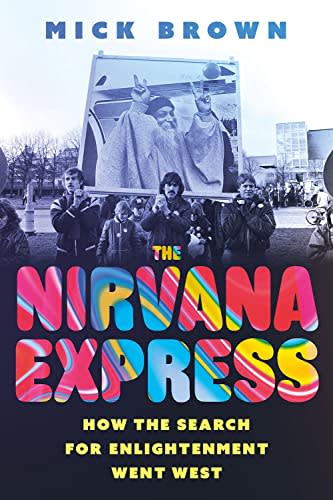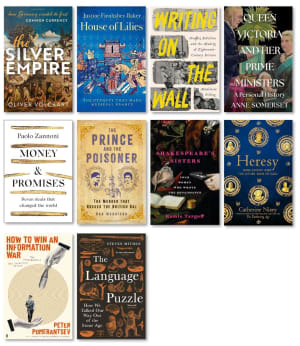My first step on the road to enlightenment occurred about ten years ago in the offices of an accounting firm in London. I was sitting in a meeting room with about twenty actuaries, my eyes closed while I listened to a colleague instructing us in meditation, or more specifically: mindfulness. I was relieved to find out that all we needed to do was close our eyes and keep breathing.
I managed to achieve a state of drowsy relaxation. Clearly enlightenment was not imminent but you’ve got to start somewhere.
At the time I didn’t appreciate that I was sitting at the end of a long line of westerners who have looked to the East in general and to India in particular for spiritual guidance and fulfilment.
Mick Brown illuminates us on those westerners and the Indian gurus they followed in Nirvana Express: How the Search for Enlightenment Went West.
The start of the journey
The trail starts with the East India Company becoming a serious force in the sub continent in the 18th century. Initially there was intense interest in the culture and religion of India from many East India Company employees, but over the decades British views became more hostile.
It took until the publication The Light of Asia by Edwin Arnold in 1879 for something like an appreciation of Eastern metaphysics to percolate into British and Western consciousnesses. The Light of Asia describes the life of the Buddha, in the form of an epic poem. You can check it out over at project Gutenberg - astoundingly Brown informs us that it went on to sell more than a million copies in Britain and America.
This represents The Nirvana Express’ starting point for a cascade of fascinating spiritual characters each influencing and sometimes inspiring the next.
Memorable Masters
The most memorable of these individuals for me were:
Krishnamurti, who was adopted / kidnapped by the crackpot Theosophist organisation at the age of thirteen in 1909, brought up to be the reincarnation of the coming Master, before disavowing the whole Theosophist project in his early twenties announcing that there is no one path to truth and rejecting the idea that he was a messiah. He dedicated the rest of his life to spreading the message that you yourself hold the keys to enlightenment.
Meher Baba, who travelled the world in the 1920s and 1930s, and who would move people to tears just by looking at them - he had taken a vow of silence and communicated by tapping out letters on an alphabet board with a stick. He loved the cinema and spent many years trying and failing to meet Greeta Garbo who he wanted to star in a film about his life.
Allan Bennett - the first ever British Buddhist monk, admired around the world for his spiritualism. He dedicated his later life to bringing Buddhism to Britain and died aged 51 of “asthma and intestinal blockage” in a London flat in Battersea in 1923. A thought provoking quote from Bennett is provided in the book:
Love is the great unraveller - love that expects nothing in return; and the immemorial heresy of the human mind is egoism... All egoism is in some measure insane, and what we admit to be insanity is but egoism overdriven.
Allan Bennett
Chemical shortcuts
The story then goes on, passing from character to character until the 1960s and 1970s when drugs such as LCD become available and appear to “open the doors of perception” offering a short cut to Nirvana. Cue round two of eccentric, flawed human beings who try, with varying degrees of integrity, to bring peace and harmony to the world.
The last guru in the book is Rajneesh, a cultic egomaniac who collected Rolls Royces and offered a highly permissive brand of spiritualism, encouraging his followers to vent their anger on each other in “encounter” sessions, and to undergo sterilisation on themselves: free love was expected but children were unwelcome.
What I liked
I was fascinated to follow the journey of discovery that we collectively went on in the West to get to know Indian religions and ideas. Brown takes you back to a time when it was possible to imagine that you really could discover the keys to existence at the feet of a guru, if only you could find the right one and concentrate hard enough.
The book also serves as a window to the world of the late 19th century. This was a time when Einstein, Heisenberg and others were discovering new worlds of space and time. In this context, searching for new previously hidden spiritual planes beyond the realms of Christianity does not seem so outlandish as it might today.
The Nirvana Express is a useful counterpoint to a “Christian history” of the West - such as expounded in Tom Holland’s book, Dominion, albeit I don’t think you would describe any of the people in the The Nirvana Express as mainstream in Western society.
Finally, it is also often pretty funny! Brown never takes any cheap shots at the people in his book - he is a sympathetic and factual observer. But it is impossible not to be amused by some of the situations that he describes.
Style guide
The book is mostly a fairly easy read, although some of the earlier sections can feel a bit dense. Generally speaking it gets easier as the gurus become more colourful.
The main trouble I had was keeping track of who was who, partly because almost all of the individuals in the book were new to me but also because there are lots of people and Brown often switches between multiple names for the same person: family name, given name and the various names or titles they accrue over their lifetimes.
Ultimately though this book can be thought of as a good yarn spun by someone who knows how to tell an engaging anecdote - or indeed a whole bookful of them.
Downsides
In my view the main weakness - or perhaps I should say omission - of the book is where it stops. By ending with the story of the bonkers Rolls Royce nut Rajneesh in the 1980s, it doesn’t really help us to understand how Eastern spiritualism has become so entrenched in the West today. As the author points out, yoga was once viewed with suspicion but is now a universal pastime, and as many people practise meditation or mindfulness in the UK as go to the Church of England on a Sunday1.
Basically, I’m still not sure how it became normal for a roomful of actuaries to meditate together over a Friday lunchtime in Canary Wharf.2
So The Nirvana Express is perhaps best thought of as a history of the most colourful Indian gurus of the last 150 years - and those who had the most influence in the West - rather than as a “history of thought”.
Conclusion
I’m very happy to have read this book. Although enlightenment remains as far away for me now as it was back in that office meeting room ten years ago, I do at least understand my spiritual forebears a little better.
I’m afraid I made up this statistic but I feel that it is a safe bet! ↩︎
Actuaries have a reputation for making accountants seem exciting, and Canary Wharf - a business district on the East side of London - is well known for its soulless corporate ambiance. It’s as far from New Age hippy vibes as you are likely to get. ↩︎
Book details
(back to top)- Title -
The Nirvana Express : How the Search for Enlightenment Went West
- Author -
Mick Brown
- Publication date -
September 2023
- Publisher -
Oxford University Press
- Pages -
428
- ISBN 13 -
9781805260196
- Podcast episode -
Books and Authors: The West Indian gurus and the search for Enlightenment
- Amazon UK -
- Amazon US -



